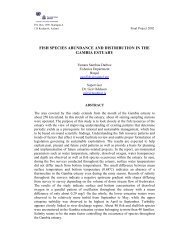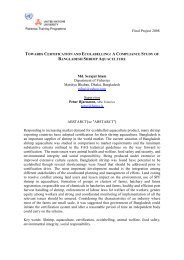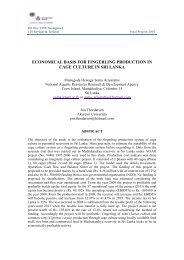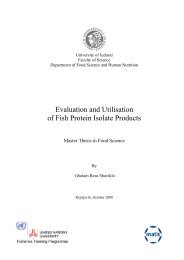Quality Indicators of Northern Shrimp (Pandalus borealis)
Quality Indicators of Northern Shrimp (Pandalus borealis)
Quality Indicators of Northern Shrimp (Pandalus borealis)
Create successful ePaper yourself
Turn your PDF publications into a flip-book with our unique Google optimized e-Paper software.
Qingzhu<strong>of</strong> the main spoilage-causing microorganism was restrained by the liquid ice. Similarresults were shown by the bacteria measurements (Figure 19).A comparison <strong>of</strong> the rates <strong>of</strong> TMA formation during 6 days <strong>of</strong> storage revealed that saltwatericed group (S-ICE/-) and iced group (ICE/+), in which TMA values exceeded10 mgN/100g, spoiled earlier than other two groups where TMA level remained below10 mgN/100g until day four <strong>of</strong> storage. The extent <strong>of</strong> increase in TVB-N and TMA <strong>of</strong>shrimp stored in liquid ice at -1.5 o C were considerably smaller than for sample groupsstored under other conditions (S-ICE/-, ICE/+).5.3 Change in pH <strong>of</strong> whole shrimpThe pH <strong>of</strong> shrimp meat gives some valuable information about its quality change.Significant differences were noticed from Figure 9 and the results <strong>of</strong> statistical analysis.There was a continued increase in pH for all sample groups, probably due metabolism <strong>of</strong>microorganisms producing alkaline compounds like amines formed by deamination <strong>of</strong>amino acids (Huss, 1988, Jackson et al. 1997). The initial post mortem pH varies withspecies, catching ground and season. Usually pH decreases during anaerobic formation <strong>of</strong>lactic acids during the first hours after death, but microbial metabolism leads to anincrease in pH during storage time. This is in good agreement with Krishnakumar et al.(1985) who showed reduction <strong>of</strong> total nitrogen in fish stored in ice sea-water and icebecause some compounds contained nitrogen were leached out. The pH changes, showedgood correlation with sensory and microbiological results. The pH changes also reflectedTVB-N and TMA accumulation and indicated the spoilage progress.5.4 CO and NH 3 responses <strong>of</strong> electronic nose measurementResults from electronic nose measurements indicate that response <strong>of</strong> NH 3 sensor can beused to evaluate the shrimp quality in a similar way as TVB-N, TMA and TVC (Table 4).The rapid onset <strong>of</strong> NH 3 production at low bacterial cell densities indicates that autolysismay be causing the production during the first day <strong>of</strong> storage and the rapid increase in therate <strong>of</strong> production during following days <strong>of</strong> storage indicates a bacterial contribution asreported by Lakshmanan et al. (2002), who found that the amine-forming bacterialpopulation in fresh shrimp was slightly higher (10 2 cfu.g -1 ) than in fish. Olafsdottir et al.(1997a, 2002) reported that the NH 3 response <strong>of</strong> electronic nose measurement gave thebest prediction <strong>of</strong> TVB in capelin raw material and was similar to the informationprovided by TMA for redfish. The CO sensor showed lower responses than the NH 3sensor, but similar overall trends for all the storage groups except for the group stored inICE/+ on day 6. It can be speculated that the decline in the CO sensor could be explainedby specific spoilage flora utilizing different substrates for their growth and thus formdifferent volatile degradation compounds. It is well known that the development <strong>of</strong>microbial metabolites changes because <strong>of</strong> competition <strong>of</strong> the micr<strong>of</strong>lora for availablesubstrates. However, this can not be confirmed because only one measurement was done.The lower responses <strong>of</strong> the CO sensor indicating lower spoilage level <strong>of</strong> samples <strong>of</strong>shrimp stored in ice is not in accordance with results from other indicators that were TVC,TVB-N and TMA in the trial. This should be studied further in combination withUNU-Fisheries Training Programme 35
















